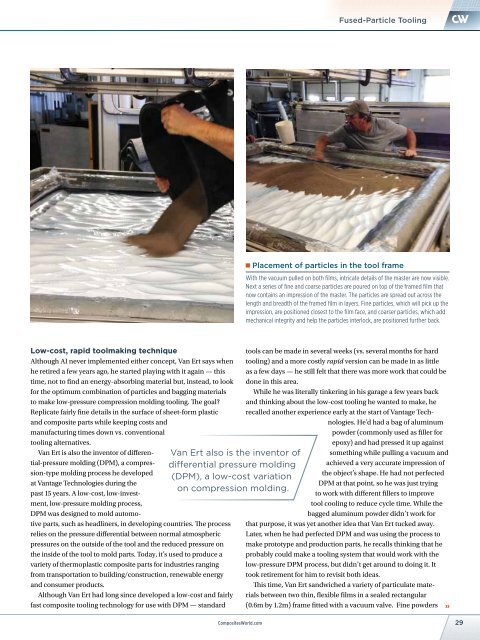FOR AUTO RTM
1VeKpGy
1VeKpGy
You also want an ePaper? Increase the reach of your titles
YUMPU automatically turns print PDFs into web optimized ePapers that Google loves.
Fused-Particle Tooling NEWS<br />
Placement of particles in the tool frame<br />
With the vacuum pulled on both films, intricate details of the master are now visible.<br />
Next a series of fine and coarse particles are poured on top of the framed film that<br />
now contains an impression of the master. The particles are spread out across the<br />
length and breadth of the framed film in layers. Fine particles, which will pick up the<br />
impression, are positioned closest to the film face, and coarser particles, which add<br />
mechanical integrity and help the particles interlock, are positioned further back.<br />
Low-cost, rapid toolmaking technique<br />
Although AI never implemented either concept, Van Ert says when<br />
he retired a few years ago, he started playing with it again — this<br />
time, not to find an energy-absorbing material but, instead, to look<br />
for the optimum combination of particles and bagging materials<br />
to make low-pressure compression molding tooling. The goal?<br />
Replicate fairly fine details in the surface of sheet-form plastic<br />
and composite parts while keeping costs and<br />
manufacturing times down vs. conventional<br />
tooling alternatives.<br />
Van Ert also is the inventor of<br />
differential pressure molding<br />
(DPM), a low-cost variation<br />
on compression molding.<br />
Van Ert is also the inventor of differential-pressure<br />
molding (DPM), a compression-type<br />
molding process he developed<br />
at Vantage Technologies during the<br />
past 15 years. A low-cost, low-investment,<br />
low-pressure molding process,<br />
DPM was designed to mold automotive<br />
parts, such as headliners, in developing countries. The process<br />
relies on the pressure differential between normal atmospheric<br />
pressures on the outside of the tool and the reduced pressure on<br />
the inside of the tool to mold parts. Today, it’s used to produce a<br />
variety of thermoplastic composite parts for industries ranging<br />
from transportation to building/construction, renewable energy<br />
and consumer products.<br />
Although Van Ert had long since developed a low-cost and fairly<br />
fast composite tooling technology for use with DPM — standard<br />
tools can be made in several weeks (vs. several months for hard<br />
tooling) and a more costly rapid version can be made in as little<br />
as a few days — he still felt that there was more work that could be<br />
done in this area.<br />
While he was literally tinkering in his garage a few years back<br />
and thinking about the low-cost tooling he wanted to make, he<br />
recalled another experience early at the start of Vantage Technologies.<br />
He’d had a bag of aluminum<br />
powder (commonly used as filler for<br />
epoxy) and had pressed it up against<br />
something while pulling a vacuum and<br />
achieved a very accurate impression of<br />
the object’s shape. He had not perfected<br />
DPM at that point, so he was just trying<br />
to work with different fillers to improve<br />
tool cooling to reduce cycle time. While the<br />
bagged aluminum powder didn’t work for<br />
that purpose, it was yet another idea that Van Ert tucked away.<br />
Later, when he had perfected DPM and was using the process to<br />
make prototype and production parts, he recalls thinking that he<br />
probably could make a tooling system that would work with the<br />
low-pressure DPM process, but didn’t get around to doing it. It<br />
took retirement for him to revisit both ideas.<br />
This time, Van Ert sandwiched a variety of particulate materials<br />
between two thin, flexible films in a sealed rectangular<br />
(0.6m by 1.2m) frame fitted with a vacuum valve. Fine powders<br />
CompositesWorld.com 29


